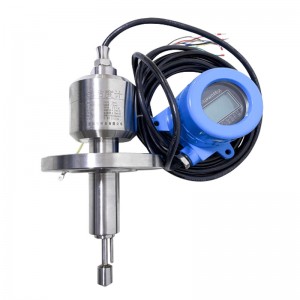Choose Lonnmeter for accurate and intelligent measurement!
Inline Oil Viscometer
The inline oil viscometer for oil or inline oil viscosity meter features a rod-shaped sensing element, which vibrates at a fixed frequency and twists torsionally along its central axis. As the element shears through the fluid over its surface, it loses energy due to viscous drag forces. These forces change based on the fluid’s viscosity: the higher the viscosity, the greater the drag, and the more energy the element dissipates. This energy loss is detected by the viscometer’s electronic components. The transmitter then processes this signal to output a clear, readable viscosity value, delivering direct insights into fluid conditions during production.
Working Principle
The inline viscometer oil employs an acoustic signal source to excite a metal tuning fork, causing the fork to vibrate at its natural resonant frequency. Notably, this resonant frequency exhibits a direct correlation with the viscosity of the liquid that the tuning fork contacts. Subsequently, the viscosity the liquid can be determined through frequency analysis—with temperature compensation implemented to counteract temperature drift within the system, ensuring measurement accuracy.
Optional Material of Wetted Parts
316 L, Teflon, Hastelloy
Repeatability
±1%
Wide Viscosity Range
1 - 1,000,000 cP
Product Features
• Real-time continuous viscosity measurement;
• Wide viscosity range 0- 1,000,000 cP and temperature range -30°C ~ 120°C;
• Built-in Modbus RTU/RS-485, 4-20 mA analog output;
• LCD display with intuitive menu for on-site configuration;
• High accuracy ±3% and repeatability ±1%;
• No-moving-parts design minimizes clogging, abrasion and maintenance;
• Low power consumption (<5W) with 24V DC supply;
• Threaded and flanged connections enable easy integration into pipeline, mixing tank or applicator feed line;
Benefits of Oil Field Viscometer
• Prevent over-thinning and over-addition of raw materials;
• Continuous monitoring make predictive maintenance possible;
• Eliminate batch rejections or customer dissatisfaction;
• Extend equipment failure and downtime caused by pump cavitation and hydraulic system failures;
• Lower possibilities of disruption in distillation or blending.
OEM & ODM Service
• Viscosity range customization;
• Material Customization of wetted parts;
• Probe length customization
Contact our engineers right now if you need exclusive OEM and ODM service.














